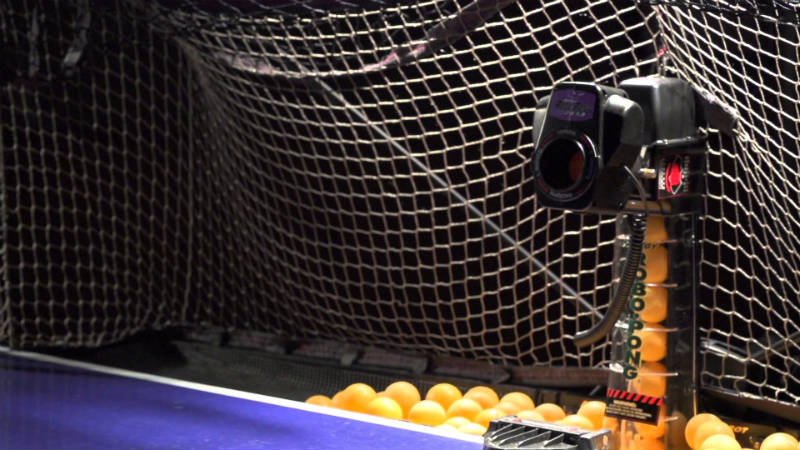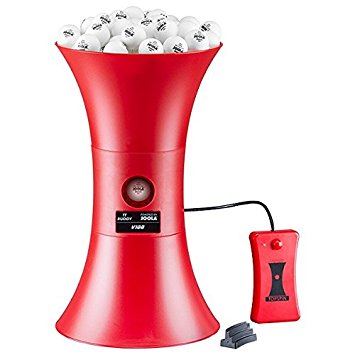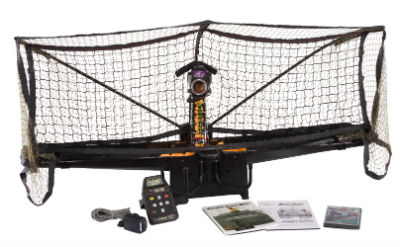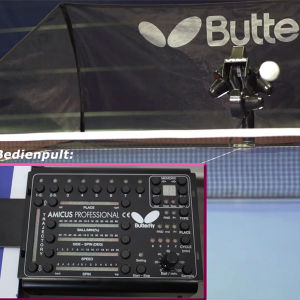
I like table tennis robots. Not everyone does, but I think they can be very useful if you use them in the right way.
My table tennis robot (Power Pong Omega) has helped me improve several areas of my game, including my topspin technique, rallying skills and footwork. Without doubt, I have become a better player by using my robot.
In this blog post, I look at the different types of table tennis robots you can buy. I’ve split robots into three different categories: entry level robots, mid-range robots and top-of-the-range multi-spin robots. I also make recommendations on which table tennis robots I think are the best and give links to where you can buy.
What can a table tennis robot actually do?
First of all let’s look at what a table tennis robot is capable of doing. Some come with just a few basic features, others are like powerful computer systems with loads of speed and spin variations and programmable training drills.
Here are some of the things a table tennis robot can do:
Ball frequency: You can change the frequency the robot shoots the ball at you. Most robots are capable of shooting 80 balls per minute. Some can do well over 100 per minute. That’s a lot of balls!
Placement: You can choose where the robot shoots the ball. Some basic robots may only shoot to two positions. Better robots can shoot balls to multiple positions and can switch between positions for each ball.
Speed: You can choose how fast the robot shoots the ball. Some robots can vary the speed of the ball. So you may get one slower ball and then one faster ball.
Spin variation: You can choose whether the robot shoots backspin, topspin, sidespin or float. Some of the entry level robots may not be able to do all of these. But the mid-range single-spin robots will be able to. And top-of-the-range multi-spin robots can also change the spin with each ball, which gives a more realistic table tennis playing experience.
Random play: You can get your robot to shoot balls in a random order. This could be random placement, random speed or random spin or everything completely random. Again, entry level robots will have more limited randomisation options. Whereas top-of the range robots will be able to do a lot more randomisation.
Service: You can tilt the robot head downwards, so that the ball bounces on the other side of the table first, replicating a table tennis serve.
Pre-set training drills: Some robots will come with pre-set training drills, where the robot will shoot the balls in a set sequence. Some pre-set training drills will also include a random element.
Programmable training drills: Some robots will allow you to programme your own training drills. You can choose the specific sequence of balls the robot shoots at you.
Ball recycling: Some robots (mainly mid-range or top-of-the-range), will come with a ball recycling facility, which is basically a collection net which funnels the ball back into the robot. This means that you don’t have to keep stopping to reload the robot. You can have continuous play.
Of course, not every table tennis robot can do all of the above. So you need to work out which features are important for you before purchasing. It’s not essential to have a robot which can do everything imaginable, but I think you will get the most out of a robot if you can (at a minimum) change the speed, spin, placement and do some random play.
Entry level table tennis robots
Entry level robots are best suited to a beginner player. They tend to have a few basic features, like being able to change ball frequency, placement and spin, but won’t have pre-set training drills and may not be able to do random play.
They are usually much smaller than mid-range and top-of-the-range robots. This has pros and cons. They are easier to set up and take less storage space. But as they are smaller, they don’t hold as many balls. So you will spend more time reloading your robot.
If you just want a robot so you can hit a few balls without doing anything complicated, an entry level robot will be good for you.
Price range:
- £100 to £500
Pros:
- Not very expensive
- Easy to set-up and use
- Easy to store or move to a different location (i.e. from home to club)
- Good for practising basic stokes
Cons:
- Limited features
- May not have random mode
- Can only produce one spin at time
- You will need to purchase a separate collection net
Recommendations
UK
- JOOLA Buddy V300 with collection net and balls
- Practice Partner 20
- Tibhar Robo Pro with collection net and balls
USA
Mid-range table tennis robots
Mid-range robots have plenty of features to test both intermediate and advanced players. They have settings to change ball frequency, ball speed, and ball placement. They can also shoot the ball in a random sequence. Some robots, such as Robo-Pong 2055, come with pre-set training drills and allow you to programme your own training drills.
So these robots offer much more than entry level robots, but they are more expensive. The other big benefit of these robots, is that they come with a ball recycling system. This sounds a bit fancy, but just means when you hit balls, they are collected in a net and then recycled into the robot. This allows you to keep playing and you spend less time refilling the robot or collecting balls from the floor.
Some robots in this price range can only produce one type of spin at a time. So any drill you do will be with the same type of spin, e.g. always topspin or always backspin. This is a limitation and something to consider before purchase. However, there are some mid-range robots, such as Power Pong Alpha, which can produce different spins with each ball.
For most amateur players, a mid-range robot will offer you enough features and challenge to keep you practising for a long time. I own a Robo-Pong 2050 robot, which I have had few years, and it still gives me a good workout, especially when I want to practice looping backspin balls and playing topspin rallies.
Price range:
- £600 to £1200
Pros:
- Many more features compared to entry level robots
- Options for random play
- Collection net and recycling facility for continuous play
Cons:
- More expensive than entry level robots
- Manual controllers, which are a little harder to use, but you’ll soon learn what to do
Recommendations:
UK
USA
Top-of-the-range multi-spin robots
These robots are fabulous, as you would expect with the hefty price tag. They can do everything a mid-range robot can do, but more of it. More speed variation. More placement variation. More training drills. More everything!
And of course, the really big advantage of these robots is that they can produce a different spin with each ball in a sequence. So the robot can shoot a backspin ball, which you loop. It then shoots a topspin ball, which you topspin/drive/hit (whatever your preferred playing style). This more closely replicates what actually happens when you play table tennis.
Some robots produced over the past two years are app controlled. This allows for more features and more drills. For example, with the Power Pong Omega app you can create a drill database. You can name your drills and even group them with tags; such as; regular, irregular, service etc.
A top-of-the-range multi-spin robot can be used by any standard of player, but advanced players will probably get most benefit from all the extra features.
I personally own the Power Pong Omega robot, which I can highly recommend. You can read my review here.
Price range:
- £1,000 to £2,000
Pros:
- Huge amount of features to test every aspect of your game
- Can produce a different spin with each ball
- Robot controlled by mobile phone / tablet app
- Will provide a useful practice partner for many years
Cons:
- Expensive – your bank balance will take a dent!
Recommendations:
UK
USA
Where to buy
You can buy a table tennis robot from many specialist table tennis shops. Take a look at my list of shops in UK, USA, Europe, Asia and Australia.
You can also sometimes find some good deals on Amazon, so worth checking here also (Amazon UK | Amazon USA)
Share your views
I hope this blog post has helped you make a decision about which table tennis robot to buy. If you do buy a robot, please let me know in the comment box below and share your thoughts on the your model. I’m sure it will help others who are thinking of buying a table tennis robot come to an informed decision too.
Personalised equipment advice
If you would like personalised equipment advice, I recommend you joining Tom’s TT Academy. In my academy, you can ask me anything about table tennis equipment and I will respond with my recommendations. You may also get recommendations from other academy members too.
In addition to equipment advice, you will also get access to a wide range of coaching content, including
- in-depth courses
- training drills
- fitness videos
- robot training videos
- member discussions
- video analysis
- skill challenges
- coaching clinic
- and lot’s more!
You can access all this content for less than £1 per week. New content is added regularly. Join hundreds of table tennis players around the world today at www.tomsttacademy.com



